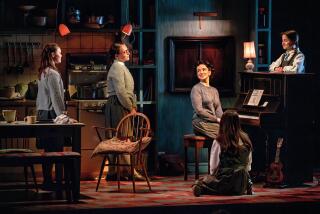STAGE REVIEW : Joyce Without Joy : Play About the Famous Writer’s Daughter Ends Without an Explanation
SAN DIEGO — On one level, Lynne Kaufman’s “Speaking In Tongues” begs comparison to Tennessee Williams’ “A Streetcar Named Desire.” Both plays deal with a protagonist woman struggling with her untapped sexuality, and in both plays, the protagonist’s trauma leads to complete mental breakdown. In “Streetcar,” Blanche lusts after her sister’s husband, Stanley Kowalski; in “Speaking in Tongues,” Lucia Joyce lusts after her father’s assistant, Patrick Gregory.
Unfortunately for the North Coast Repertory Theatre, which is presenting Kaufman’s play through May 24, all similarities between the two scripts end there. While “Streetcar” is a multilayered drama dealing with societal pressures, personal politics and sweeping cultural changes, “Speaking in Tongues” remains just a story about a young woman who tries to seduce a young man and fails.
This sort of minor plotline can make for perfectly acceptable theater, but--like Williams’ Blanche DuBois--”Speaking in Tongues” puts on “airs” and pretends to be more substantial than it really is.
Set in the Paris home of novelist James Joyce, the 80-minute play begins innocently enough with several solid introductory scenes. The audience meets the author (Gary Seger), his wife Nora (Karen Lust), daughter Lucia (Stina Sundberg) and the author’s handsome, overly scholastic assistant, Patrick Gregory (Stanley Madruga, Jr.). During this exposition, James Joyce unleashes a few witty quips (“Americans don’t read books, but they do buy them.”), and the audience sees Lucia for what she is: a confused young woman with a famous father.
Soon thereafter, playwright Kaufman begins to tread on dangerous ground by attempting to draw parallels between daughter and father. The stream-of-consciousness similarities are prevalent: “Sometimes the words just come out of my mouth,” Lucia says, “they don’t go through my brain.” When father and daughter sit together late in Act I and jointly recite a favorite story, the playwright’s message becomes clear: James and Lucia Joyce are alike, but James has a creative outlet for his passions--literature--while Lucia has none.
More important for the purposes of this play, Lucia has no outlet for her sexual passions. Kaufman, writing in flurries of Freudian analysis and sexual imagery, suggests that Lucia is going mad because she has no lover. This crucial plot element is sorely underdeveloped in this play: Lucia tries to seduce one man, fails, and immediately falls into a cataclysmic despair. The play ends with Lucia in a straitjacket and the audience is left to wonder why--the script certainly doesn’t tell them.
Sundberg’s portrayal of Lucia Joyce is an earnest effort, but a futile one nonetheless. In playwright Kaufman’s hands, Lucia’s mental collapse lacks texture and seems merely to happen rather than to evolve or develop. Sundberg put her best foot forward in this production, but still tripped on some very clumsy material.
As James Joyce, Seger handles the language of the text capably. He struggles to capture the emotional trauma of a father watching his daughter fall apart before him. Lust’s Nora Joyce is strong and consistent throughout the play. Also disappointing, Lust’s Irish accent proves to be the only passable dialect of the evening.
Madruga’s take on the Parisian scholar Patrick Gregory warding off Lucia’s advances with believability and compassion is the highlight of this production. Late in the play, when Patrick discovers he can no longer visit the Joyce home, his restrained display of sorrow fills every inch of the long, shallow North Coast Rep stage.
North Coast Rep resident designer Ocie Robinson created a wonderful environment for “Speaking in Tongues.” Perhaps informed by Joyce’s stream of consciousness writing, Robinson’s design flowed gracefully between functional reality and abstract artistry. Robinson’s set included an upstage exterior tree which twisted its way downstage to form the interior ceiling of the Joyce home. The blatantly oversized roses in the garden also added to the lovely stage picture.
Costume designer John Bryan-Davis delivered his usual good work, outfitting the cast in functional, appropriate costumes. The costumes, particularly Nora’s dresses and James’ suits, helped transport the play to 1932 Paris.
“SPEAKING IN TONGUES”
Written by Lynne Kaufman. Directed by Olive Blakistone. Set/lighting design by Ocie Robinson. Costume design by John Bryan-Davis. Sound design by Marvin Read. With Gary Seger, Karen Lust, Stanley Madruga, Jr., Stina Sundberg and Larry Corodemas. At 8 p.m. Thursday through Saturday, at 2 and 7 p.m. Sunday through May 24. Tickets are $12-$14. 481-1055. At 987D Lomas Santa Fe Drive, Solana Beach.
More to Read
The biggest entertainment stories
Get our big stories about Hollywood, film, television, music, arts, culture and more right in your inbox as soon as they publish.
You may occasionally receive promotional content from the Los Angeles Times.










